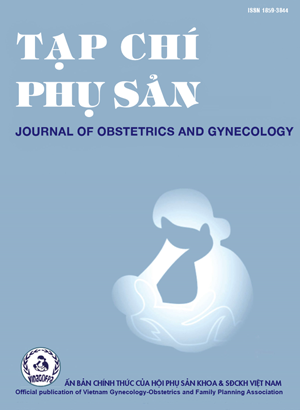Tóm tắt
Mục tiêu: Khảo sát sự phát triển tâm thần, vận động sau sinh của trẻ được chẩn đoán thiểu sản - bất sản thể chai trong thai kỳ.
Đối tượng và phương pháp nghiên cứu: Báo cáo loạt ca 30 trường hợp trẻ sinh sống và được chẩn đoán thiểu sản - bất sản thể chai trong thai kỳ.
Kết quả: Bất sản thể chai đơn độc chiếm 63% (19 ca), bất sản thể chai phức tạp chiếm 23% (7 ca) và thiểu sản thể chai đơn độc chiếm 14% (4 ca).
Có 23 ca đồng ý chọc ối, chiếm 77%. Trong đó, có 2 ca cho kết quả bất thường, chiếm 9%, gồm vi mất đoạn nhiễm sắc thể 17: del (17) (q25.3) và vi mất đoạn nhiễm sắc thể 12: del (12) (q24.31).
Tuổi trung bình của các trẻ tại thời điểm đánh giá sự phát triển tâm vận là: 41,86 ± 11,18 tháng.
Tỉ lệ điểm ASQ-3 (Ages & Stages Third Edition) bình thường về mặt giao tiếp, vận động thô, vận động tinh, giải quyết vấn đề, cá nhân - xã hội lần lượt là 73%; 87%; 80%; 77%; 70%.
Điểm số cá nhân-xã hội và giao tiếp của trẻ thiểu sản - bất sản thể chai chiếm tỉ lệ bất thường cao nhất.
Thiểu sản thể chai có vẻ có kết cục về phát triển tâm vận tốt hơn bất sản thể chai. Bất sản thể chai đơn độc có vẻ có kết cục về phát triển tâm vận tốt hơn bất sản thể chai phức tạp.
Kết luận: Kết cục phát triển tâm vận ở mức bình thường của trẻ được chẩn đoán thiểu sản - bất sản thể chai đạt trên 70%.
Tài liệu tham khảo
2. Kim SE, Jang H-I, Chang KH-j, Sung J-H, Lee J, Lee J, et al. Clinical outcomes and neurodevelopmental outcome of prenatally diagnosed agenesis of corpus callosum in single center of Korea. Obstetrics & gynecology science. 2017;60(1):8-17.
3. Lanna M, Nelva L, Faiola S, Casati D, Laoreti A, Balestriero M, Cetin I, Scelsa B. Long-term outcome of fetuses with isolated complete agenesis of corpus callosum. Ultrasound in Obstetrics & Gynecology. 2021; 58 (1): 3.
4. Folliot et al. Neurodevelopmental outcome in prenatally diagnosed isolated agenesis of the corpus callosum. Early Hum Dev. 2018; (116):9-16.
5. Raile Vera Raile et al. Clinical Outcome of Children With Corpus Callosum Agenesis. Pediatr Neurol. 2020; (112):47-52.
6. Sara Bernardes da Cunha et al. Neurodevelopmental Outcomes following Prenatal Diagnosis of Isolated Corpus Callosum Agenesis: A Systematic Review. Fetal Diagn Ther. 2021; 48(2):88-95.
7. W.S. Brown, M. Symingtion, D. VanLancker-Sidtis, R. Dietrich, L.K. Paul.
Paralinguistic processing in children with callosal agenesis: emergence of neurolinguistic deficits. Brain Lang. 93 (2) (2005) 135–139.
8. B. Lábadi, A.M. Beke. Mental state understanding in children with agenesis of the
corpus callosum. Front. Psychol. 8 (2017) 94.
9. Sung Eun Kim, Hye-In Jang, Kylie Hae-jin Chang, Ji-Hee Sung, Jiwon Lee, Jeehun Lee, Suk-Joo Choi, Soo-young Oh,Cheong-Rae Roh, Jong-Hwa Kim. Clinical outcomes and neurodevelopmental outcome of prenatally diagnosed agenesis of corpus callosum in single center of Korea. Obstet Gynecol Sci. (2017) 60(1): 8–17.
10. Jagoda Hofman, Michał Hutny, Karolina Sztuba, Justyna Paprocka. Corpus Callosum Agenesis: An Insight into the Etiology and Spectrum of Symptoms. Brain Sci. (2020) 10(9): 625
11. DeWan, A. T., Parrado, A. R., Leal, S. M. A second kindred linked to DFNA20 (17q25.3) reduces the genetic interval. Clin. Genet. 63: 39-45, 2003.
12. Labonne, J. D. J., Lee, K.-H., Iwase, S., Kong, I.-K., Diamond, M. P., Layman, L. C., Kim, C.-H., Kim, H.-G. An atypical 12q24.31 microdeletion implicates six genes including a histone demethylase KDM2B and a histone methyltransferase SETD1B in syndromic intellectual disability. Hum. Genet. 135: 757-771, 2016.

Công trình này được cấp phép theo Creative Commons Attribution-NonCommercial-NoDerivatives 4.0 International License. .

